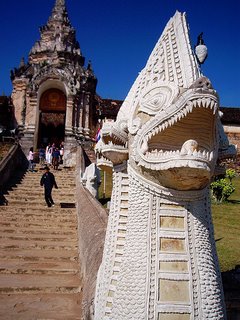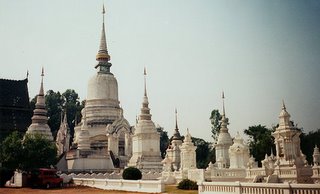
Chiang Mai is
Thailand's principal northern city. Chiang Mai is the pro-vincial capital of a largely mountainous province, also called Chiang Mai, which is some 20,000 square kilometres in area.
Chiang Mai city is 700 kilometres north of Bangkok, was founded in 1296, and is located in a fertile valley some 300 matres above sea level.
Chiang Mai was the capital of Lanna Thai (Kingdom of One Million Ricefields), the first independent Thai kingdom within the fabled Golden Triangle. Chiang Mai flourished as a major religious, cultural and trading centre until 1556 when a Burmese invasion reduced it to a vassal state. The Burmese were expelled in 1785, whereupon Lanna Thai once again became part of northern Thailand.
Many lowland Thais regard Chiang Mai city and province as being something of a national Shangri-la, thanks to its beautiful women, distinctive festivals, historic temples dating from the 1300s, arresting scenic beauty, temperate fruits such as apples peaches and strawberries, and a crisp, invigorating cool season climate
Places that you should visit:
Wat Phra Singh
Sam Lan Road
This lovely temple dates from 1345 and is one of the focal points of Songkran festivities each April 13-15 when people bathe the revered Phra Buddha Sihing image. The temple compound includes the lovely Lai Kham chapel with its exquisite woodcarvings and northern-style murals, and a magnificent scriptural repository with striking teas relief.
Wat Suan Dok
Suthep Road
This temple was built in a 14th century Lanna Thai
monarch's pleasure gardens and is a favourite spot for photographers, particularly for striking sunsets. Several of the white chedis contain ashes of Chiang Mai's former royal family. The 500-year-old bronze Buddha image in a secondary chapel is one of Thailand's largest metal images.
Wat Chiang Man
Ratchaphakkinai Road
This is Chiang Mai's oldest temple and probably dates from 1296. The temple was the residence of King Mengrai, who founded Chiang Mai, and is noteworthy for a chedi supported by rows of elephantine buttresses, and a small ancient Buddha image, Phra Kaeow Khaow.
Wat Ku Tao
near Chiang Mai Stadium
This temple is noteworthy for an unusual bulbous pagoda. The structure is decorated with colourful porcelain chips and is believed to represent five Buddhist monks' alms bowls which symbolise five Lord Buddhas.
Wat Chedi Luang
Phrapokklao Road
This temple is the site of an enormous pagoda, originally 280 feet high, and which was partially destroyed by an earthquake in 1545. At one time, Wat Chedi Luang housed the revered Emerald Buddha image now enshrined in Bangkok's Wat Phra Kaeo. A magnificent Naga staircase adorns the chapel's front porch.
Wat Chet Yot
Super Highway, north of the Huai
Kaew Nimmanhemin Roads intersection
This temple dates from 1458. The seven-spired square chedi was inspired by designs at Bodhagaya, the site of the Buddha's Enlightenment in north India over 2,500 years ago, and was built by Lanna Thai architects after visiting the holy site.
Wat U-Mong
Suthep Road
This delightful meditation temple is completely different from Chiang Mai's other major temples and enjoys a bucolic forest setting. The ancient chedi is of particular interest.

Source: http://sunsite.au.ac.th
 Chiang Mai is
Chiang Mai is 











 Chiang Mai is
Chiang Mai is 











0 Comments:
Post a Comment
<< Home